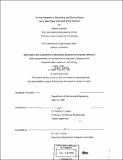| dc.contributor.advisor | Robert S. Langer. | en_US |
| dc.contributor.author | Alamaro, Moshe, 1948- | en_US |
| dc.contributor.other | Massachusetts Institute of Technology. Dept. of Mechanical Engineering. | en_US |
| dc.date.accessioned | 2009-06-30T18:46:52Z | |
| dc.date.available | 2009-06-30T18:46:52Z | |
| dc.date.copyright | 1999 | en_US |
| dc.date.issued | 1999 | en_US |
| dc.identifier.uri | http://hdl.handle.net/1721.1/46275 | |
| dc.description | Thesis (M.Eng.)--Massachusetts Institute of Technology, Dept. of Mechanical Engineering, 1999. | en_US |
| dc.description | Includes bibliographical references (leaves 113-116). | en_US |
| dc.description.abstract | Summer water shortages have become a problem in Southeastern Massachusetts, communities in Vermont, New Hampshire and Rhode Island, and in a few areas in the Great Plains. This thesis proposes a conceptual system and outlines its feasibility for the production of large masses of ice in the winter within or in the vicinity of existing water reservoirs, thereby increasing their effective capacity without the need for an extensive or permanent water storage infrastructure. Eastern Massachusetts, for example, has an approximate average of 600 cold hours per winter when the temperature is below -4 C. According to this concept, during these subfreezing temperature periods, ice would be produced by spraying water into the air and letting it freeze during free-fall as in the production of artificial snow. The pile of ice would then melt gradually during the spring and summer to provide a continuous supply of water. This study is the first step toward anticipated development of a pilot system and subsequent implementation. Major engineering issues of such an approach are: atomization and spraying of water and heat transfer between the water drop and the air. A heat transfer model, which considers the drop size, free fall time, atmospheric temperature, humidity and nucleation, has been developed. The goal of the model is to enable the optimization of such an operation so as to minimize the required pumping power. Insulation techniques to preserve the ice for the summer are also outlined. Economic comparison with other alternatives for alleviation of water shortages such as water desalination was also made. Environmental evaluations consider potential disruption to nearby communities in the form of ice-making noise, icing and anticipated adversarial public perception of the concept. Other applications for winter-produced ice that may further improve the economic benefits of such an approach were also investigated. | en_US |
| dc.description.statementofresponsibility | by Moshe Alamaro. | en_US |
| dc.format.extent | 116 leaves | en_US |
| dc.language.iso | eng | en_US |
| dc.publisher | Massachusetts Institute of Technology | en_US |
| dc.rights | M.I.T. theses are protected by
copyright. They may be viewed from this source for any purpose, but
reproduction or distribution in any format is prohibited without written
permission. See provided URL for inquiries about permission. | en_US |
| dc.rights.uri | http://dspace.mit.edu/handle/1721.1/7582 | en_US |
| dc.subject | Mechanical Engineering. | en_US |
| dc.title | On the feasibility of generating and storing winter ice to meet water demands in the summer | en_US |
| dc.type | Thesis | en_US |
| dc.description.degree | M.Eng. | en_US |
| dc.contributor.department | Massachusetts Institute of Technology. Department of Mechanical Engineering | |
| dc.identifier.oclc | 47087668 | en_US |
